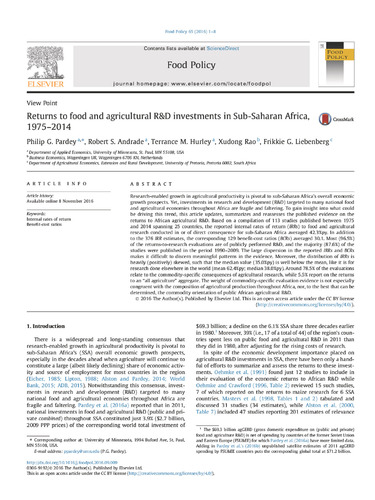Returns to food and agricultural R&D investments in Sub-Saharan Africa, 1975–2014
Research-enabled growth in agricultural productivity is pivotal to sub-Saharan Africa's overall economic growth prospects. Yet, investments in research and development (R&D) targeted to many national food and agricultural economies throughout Africa are fragile and faltering. To gain insight into what could be driving this trend, this article updates, summarizes and reassesses the published evidence on the returns to African agricultural R&D. Based on a compilation of 113 studies published between 1975 and 2014 spanning 25 countries, the reported internal rates of return (IRRs) to food and agricultural research conducted in or of direct consequence for sub-Saharan Africa averaged 42.3%py. In addition to the 376 IRR estimates, the corresponding 129 benefit-cost ratios (BCRs) averaged 30.1. Most (96.5%) of the returns-to-research evaluations are of publicly performed R&D, and the majority (87.6%) of the studies were published in the period 1990-2009. The large dispersion in the reported IRRs and BCRs makes it difficult to discern meaningful patterns in the evidence. Moreover, the distribution of IRRs is heavily (positively) skewed, such that the median value (35.0%py) is well below the mean, like it is for research done elsewhere in the world (mean 62.4%py; median 38.0%py). Around 78.5% of the evaluations relate to the commodity-specific consequences of agricultural research, while 5.5% report on the returns to an "all agriculture" aggregate. The weight of commodity-specific evaluation evidence is not especially congruent with the composition of agricultural production throughout Africa, nor, to the best that can be determined, the commodity orientation of public African agricultural R&D.

